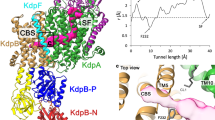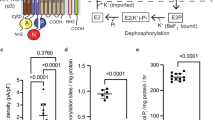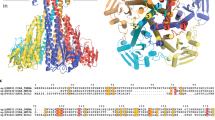Abstract
P-type ATPase pumps generate concentration gradients of cations across membranes in nearly all cells. They provide a polar transmembrane pathway, to which access is strictly controlled by coupled gates that are constrained to open alternately, thereby enabling thermodynamically uphill ion transport (for example, see ref. 1). Here we examine the ion pathway through the Na+,K+-ATPase, a representative P-type pump, after uncoupling its extra- and intracellular gates with the marine toxin palytoxin2. We use small hydrophilic thiol-specific reagents3 as extracellular probes and we monitor their reactions, and the consequences, with cysteine residues introduced along the anticipated cation pathway through the pump. The distinct effects of differently charged reagents indicate that a wide outer vestibule penetrates deep into the Na+,K+-ATPase, where the pathway narrows and leads to a charge-selectivity filter. Acidic residues in this region, which are conserved to coordinate pumped ions, allow the approach of cations but exclude anions. Reversing the charge at just one of those positions converts the pathway from cation selective to anion selective. Close structural homology among the catalytic subunits of Ca2+-, Na+,K+- and H+,K+-ATPases4,5,6 argues that their extracytosolic cation exchange pathways all share these physical characteristics.
This is a preview of subscription content, access via your institution
Access options
Subscribe to this journal
Receive 51 print issues and online access
$199.00 per year
only $3.90 per issue
Buy this article
- Purchase on Springer Link
- Instant access to full article PDF
Prices may be subject to local taxes which are calculated during checkout




Similar content being viewed by others
References
Lauger, P. Electrogenic Ion Pumps (Sinauer, Sunderland, Massachusetts, 1991)
Artigas, P. & Gadsby, D. C. Na+/K+-pump ligands modulate gating of palytoxin-induced ion channels. Proc. Natl Acad. Sci. USA 21, 501–505 (2003)
Karlin, A. & Akabas, M. H. Substituted-cysteine accessibility method. Methods Enzymol. 293, 123–145 (1998)
Sweadner, K. J. & Donnet, C. Structural similarities of Na,K-ATPase and SERCA, the Ca2+-ATPase of the sarcoplasmic reticulum. Biochem. J. 356, 685–704 (2001)
Ogawa, H. & Toyoshima, C. Homology modeling of the cation binding sites of Na+K+-ATPase. Proc. Natl Acad. Sci. USA 99, 15977–15982 (2002)
Munson, K., Garcia, R. & Sachs, G. Inhibitor and ion binding sites on the gastric H,K-ATPase. Biochemistry 44, 5267–5284 (2005)
Toyoshima, C., Nakasako, M., Nomura, H. & Ogawa, H. Crystal structure of the calcium pump of sarcoplasmic reticulum at 2.6 Å resolution. Nature 405, 647–655 (2000)
Toyoshima, C. & Nomura, H. Structural changes in the calcium pump accompanying the dissociation of calcium. Nature 418, 605–611 (2002)
Rakowski, R. F. & Sagar, S. Found: Na+ and K+ binding sites of the sodium pump. News Physiol. Sci. 18, 164–168 (2003)
Toyoshima, C., Nomura, H. & Tsuda, T. Lumenal gating mechanism revealed in calcium pump crystal structures with phosphate analogues. Nature 432, 361–368 (2004)
Moller, J. V., Nissen, P., Sorensen, T. L.-M. & le Marie, M. Transport mechanism of the sarcoplasmic reticulum Ca2+-ATPase pump. Curr. Opin. Struct. Biol. 15, 387–393 (2005)
Picard, M., Toyoshima, C. & Champeil, P. Effects of inhibitors on luminal opening of Ca2+ binding sites in an E2P-like complex of sarcoplasmic reticulum Ca2+-ATPase with Be2+-fluoride. J. Biol. Chem. 281, 3360–3369 (2006)
Scheiner-Bobis, G., Meyer zu Heringdorf, D., Christ, M. & Habermann, E. Palytoxin induces K+ efflux from yeast cells expressing the mammalian sodium pump. Mol. Pharmacol. 45, 1132–1136 (1994)
Guennoun, S. & Horisberger, J.-D. Structure of the 5th transmembrane segment of the Na,K-ATPase α subunit: a cysteine-scanning mutagenesis study. FEBS Lett. 482, 144–148 (2000)
Horisberger, J.-D. Recent insights into the structure and mechanism of the sodium pump. Physiology (Bethesda) 19, 377–387 (2004)
Nielsen, J. M., Pedersen, P. A., Karlish, S. J. & Jorgensen, P. L. Importance of intramembrane carboxylic acids for occlusion of K+ ions at equilibrium in renal Na,K-ATPase. Biochemistry 37, 1961–1968 (1998)
Artigas, P. & Gadsby, D. C. Large diameter of palytoxin-induced Na/K pump channels and modulation of palytoxin interaction by Na/K pump ligands. J. Gen. Physiol. 123, 357–376 (2004)
Keramidas, A., Moorhouse, A. J., Schofield, P. R. & Barry, P. H. Ligand-gated ion channels: mechanisms underlying ion selectivity. Prog. Biophys. Mol. Biol. 86, 161–204 (2004)
Zhang, P., Toyoshima, C., Yonekura, K., Green, N. M. & Stokes, D. L. Structure of the calcium pump from sarcoplasmic reticulum at 8-Å resolution. Nature 392, 835–839 (1998)
Olesen, C., Sorensen, T. L., Nielsen, R. C., Moller, J. V. & Nissen, P. Dephosphorylation of the calcium pump coupled to counterion occlusion. Science 306, 2251–2255 (2004)
Qiu, L. Y., Koenderink, J. B., Swarts, H. G., Willems, P. H. & De Pont, J. J. Phe783, Thr797, and Asp804 in transmembrane hairpin M5–M6 of Na+,K+-ATPase play a key role in ouabain binding. J. Biol. Chem. 278, 47240–47244 (2003)
Asano, S. et al. The cavity structure for docking the K+-competitive inhibitors in the gastric proton pump. J. Biol. Chem. 279, 13968–13975 (2004)
Apell, H. J. Structure–function relationship in P-type ATPases—a biophysical approach. Rev. Physiol. Biochem. Pharmacol. 150, 1–35 (2003)
Vilsen, B. & Andersen, J. P. Mutation to the glutamate in the fourth membrane segment of Na+,K+-ATPase and Ca2+-ATPase affects cation binding from both sides of the membrane and destabilizes the occluded enzyme forms. Biochemistry 37, 10961–10971 (1998)
Inesi, G., Ma, H., Lewis, D. & Xu, C. Ca2+ occlusion and gating function of Glu309 in the ADP-fluoroaluminate analog of the Ca2+-ATPase phosphoenzyme intermediate. J. Biol. Chem. 279, 31629–31637 (2004)
Price, E. M., Rice, D. A. & Lingrel, J. B. Structure–function studies of Na,K-ATPase: site-directed mutagenesis of the border residues from the H1–H2 extracellular domain of the α subunit. J. Biol. Chem. 265, 6638–6641 (1990)
Verrey, F. et al. Primary sequence of Xenopus laevis Na+-K+-ATPase and its localization in A6 kidney cells. Am. J. Physiol. 256, F1034–F1043 (1989)
Good, P. J., Richter, K. & Dawid, I. B. A nervous system-specific isotype of the β subunit of Na+,K+-ATPase expressed during early development of Xenopus laevis. Proc. Natl Acad. Sci. USA 87, 9088–9092 (1990)
Artigas, P. & Gadsby, D. C. Ouabain affinity determining residues lie close to the Na/K pump ion pathway. Proc. Natl Acad. Sci. USA 103, 12613–12618 (2006)
Grenthe, I., Plyasunov, A. V. & Spahiu, K. In Modelling in Aquatic Chemistry (eds Grenthe, I. & Puigdomenech, I.) 325–426 (Organisation for Economic Co-operation and Development (OECD) Publications, Paris, 1997)
Acknowledgements
We thank P. Artigas for advice and discussion; M. Mense and P. Vergani for discussion; and R.F. Rakowski for cDNAs encoding the Xenopus α1 and β Na+,K+-ATPase subunits. This work was supported by a grant from the NIH (to D.C.G.).
Author information
Authors and Affiliations
Corresponding author
Ethics declarations
Competing interests
Reprints and permissions information is available at www.nature.com/reprints. The authors declare no competing financial interests.
Supplementary information
Supplementary Figures
Supplementary Figures 1 and 3 provide stereo views of Figs. 1b and 4b, respectively. Supplementary Figure 2 shows accessibility of differently charged MTS reagents in mutant V807C. Supplementary Figure 4 illustrates likely arrangements of ion-coordinating residues in different functional states of the Na+,K+-ATPase. (PDF 456 kb)
Supplementary Methods
Supplementary methodological details of our experimental approach are appended (PDF 75 kb)
Rights and permissions
About this article
Cite this article
Reyes, N., Gadsby, D. Ion permeation through the Na+,K+-ATPase. Nature 443, 470–474 (2006). https://doi.org/10.1038/nature05129
Received:
Accepted:
Issue Date:
DOI: https://doi.org/10.1038/nature05129
This article is cited by
-
Engineering Multi-field-coupled Synergistic Ion Transport System Based on the Heterogeneous Nanofluidic Membrane for High-Efficient Lithium Extraction
Nano-Micro Letters (2023)
-
ATP1A3 mutation as a candidate cause of autosomal dominant cone-rod dystrophy
Human Genetics (2020)
-
Mechanism of potassium ion uptake by the Na+/K+-ATPase
Nature Communications (2015)
-
Ion channels versus ion pumps: the principal difference, in principle
Nature Reviews Molecular Cell Biology (2009)
-
The ion pathway through the opened Na+,K+-ATPase pump
Nature (2008)
Comments
By submitting a comment you agree to abide by our Terms and Community Guidelines. If you find something abusive or that does not comply with our terms or guidelines please flag it as inappropriate.



